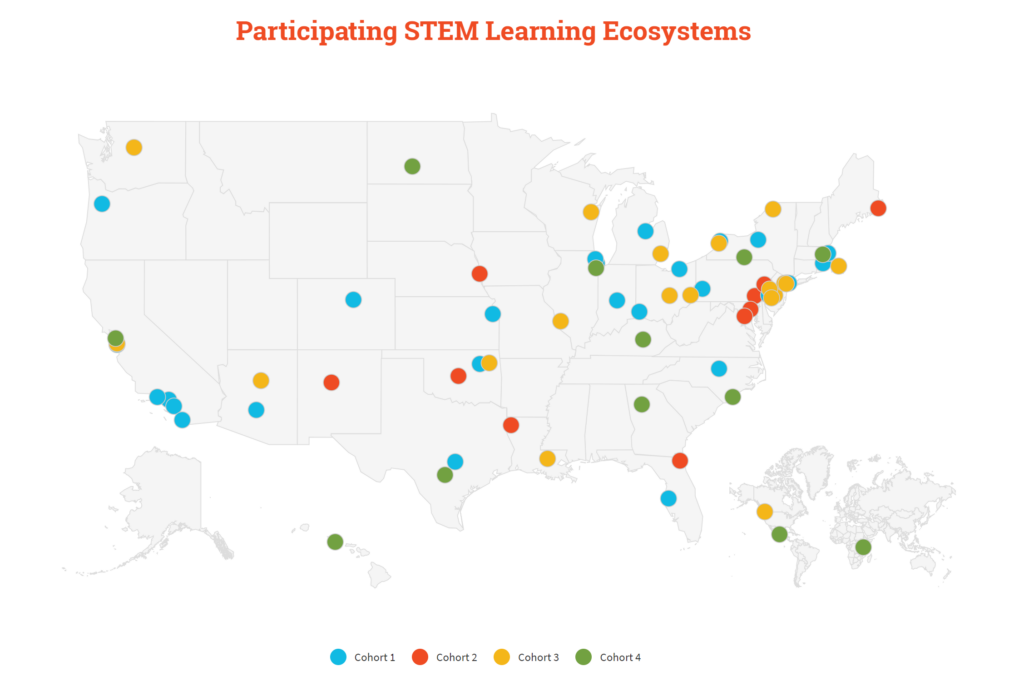(Corona del Mar, CA – May 29, 2018) – The STEM Learning Ecosystems Community of Practice has selected 12 additional networks to join the organization, which builds community partnerships focused on science, technology, engineering and math (STEM) education as pathways for life-long learning and success.
There will now be 68 regional hubs of education connections in the United States, Canada, Mexico and Kenya.
STEM Learning Ecosystems build strong collaborations in schools and beyond—in afterschool and summer programs, at home, with local business and industry partners, and in science centers, libraries and other places. Ecosystems strive to enable students to connect what they learn at home, in school and out-of-school with real-world opportunities. Additionally, the Ecosystems develop close ties with each other, so they can share ideas and lessons learned.
“Across the world, educators are striving to ensure that youth that are well-prepared for the shifting demands of a technology-centric society,” said Ron Ottinger, co-founder of STEM Learning Ecosystems and executive director of the STEM Next Opportunity Fund. “We’re helping communities design learning systems that build a solid foundation of skills and incorporate a rich variety of hands-on experiences based on the regional economy.”
Gerald Solomon, co-founder of STEM Learning Ecosystems and executive director of the Samueli Foundation, said, “Ecosystems are locally designed, so they all look slightly different. The common thread is that they benefit all of society with a focus on under-represented populations – which also look vastly different.
“Struggles vary from rural towns to inner cities, from Kentucky to Kenya, but every community is intently focused on leveraging STEM-based education to provide opportunities and social mobility.”
Jan Morrison, president and CEO of TIES, which provides support to the SLECOP communities, said the 4-year-old initiative is credited with changing how millions of students learn. “The challenges facing society are not isolated; they cross borders and oceans. We’re thrilled to be able to positively impact the education of individual children and entire nations by improving education systems around the world,” she said.
New STEM Learning Ecosystems in the United States are:
- California: East Bay STEM Network
- Georgia: Atlanta STEAM Learning Ecosystem
- Hawaii: Hawai’iloa ecosySTEM Cabinet
- Illinois: South Suburban STEAM Network
- Kentucky: Southeastern Kentucky STEM Ecosystem
- Massachusetts: MetroWest STEM Education Network
- New York: Greater Southern Tier STEM Learning Network
- North Carolina: STEM SENC (Southeastern North Carolina)
- North Dakota: North Dakota STEM Ecosystem
- Texas: SA/Bexar STEM/STEAM Ecosystem
The growing global Community of Practice has added:
- Kenya: Kenya National STEM Learning Ecosystem
- México: Alianza Para Promover la Educación en STEM (APP STEM)
The importance of grass-roots Ecosystem development was recently highlighted in a report on the State of STEM from STEMConnector[1] (an unrelated organization). The report states: “sustainable change happens at the community level. Quite simply, the systemic impact we want to create must follow from the deliberate effort of committed practitioners on the ground.” The report also suggested that there is an “overall opportunity gap for individual students and job seekers, a workforce development challenge for educators, and a business imperative for employers. Closing these gaps will require more than simply creating or investing in a new program. It will require cross-sector coordination of practice, funding, and policymaking.”
Today, STEM Learning Ecosystems are hard at work across the world building all-important community networks as well as global connections to yield the sustainable education improvements that students deserve and the working world requires. The continued growth of the Ecosystem movement is a testament to its progress.
Learn more about STEM Learning Ecosystems at stemecosystems.org. Address specific questions to info@stemecosystems.org. Join our online conversations on Twitter @STEMecosystems and #STEMecosystems and on Facebook and LinkedIn.
The STEM Learning Ecosystems Community of Practice is supported by the STEM Funders Network.
###
[1] https://www.stemconnector.com/state-stem-report/

